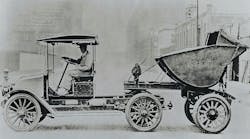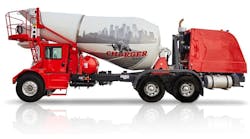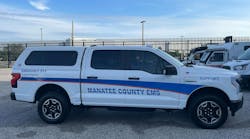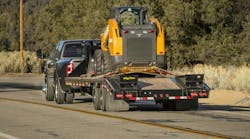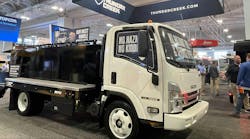Items:
Sometimes less is necessary. The seemingly fast-fading recession reined in spending and rendered waste from many corporations, including those that build trucks. Tight money and new government regulations have weeded out several slow-selling models, leaving room for more successful and useful vehicles. There remains a truck or tractor for every purpose, if not every preference.
Options lists have been pared by growing "strategic alliances" among builders of heavy trucks and component suppliers, while consolidation of ownership has accelerated in recent years. These developments have pushed Class 8 manufacturing toward "vertical integration," where a truck builder makes or controls most of the parts that go into his vehicles. Buyers of light- and medium-duty trucks take it for granted, but surveys show most heavy-truck customers don't like it.
News in Class 8 trucks continues to be dominated by engines—primarily, the greater complexity and higher cost brought by the latest exhaust emissions regulations. These went into effect in October 2002 for most builders, and those exempt at that time now face them effective this January. Builders are pondering what will be needed to meet the next round of limits, coming in January 2007.
However, there is almost no angst among midrange truck customers over the new, costlier '04 engines, perhaps because these people use their trucks as part of larger businesses, and are not primarily truckers.
Manufacturers of Class 6 and 7 trucks report sales of more automatic and automated transmissions. Overall percentages range from 30 to 100, depending on application, as operators realize productivity and maintenance benefits to be had with easy-to-drive trucks. The trend has accelerated steadily since the early '90s. Allison automatics still account for the bulk of midrange sales, but Eaton automated mechanical products are catching on and a Mercedes-Benz product will soon be available on medium-duty Freightliners and Sterlings.
Conventionals continue to constitute 80 to 90 percent of medium-duty sales here, depending on locale, and that's where domestic builders are putting their money. Hino, which has imported only low-cabovers, is converting to conventionals. This month, it's unveiling Class 4 through 7 conventional-cab models with Hino diesels and North American driveline components. And it plans to significantly expand its dealer network.
Aside from expansion of models in the various midrange weight classes, four domestic builders now offer extended cabs and four-door crew cabs, and several can build a 4×4 or 6×6, either right in the factory or at a nearby modification center.
Quality of cabs, chassis and components continues to increase, as manufacturers refine their assembly lines, motivate their workers and, in general, better the craft of truck building. Trucks contain more electronic circuitry, which make them run better, but are the devil to deal with for the technologically ignorant or inept.
The October 2002 emissions regulations have affected domestic diesel builders—those who suffered the wrath of the Environmental Protection Agency for alleged cheating in the '90s—and their customers. These include buyers of medium and heavy trucks powered by Caterpillar, Cummins, International, Mack and Volvo diesels.
Come January 2004, all diesels will have to meet the same limits, so more trucks will go up in price. These include GM, Isuzu and the imports—all those diesel builders not penalized by the EPA in its consent decree. Most engine makers not already using exhaust-gas recirculation say they will. Caterpillar, of course, is neither using EGR for its "bridge" Clean Power diesels nor its new ACERTed models.
Paring PowerMost Class 8 truck builders used the changeover to October '02 engines to pare their power options. Freightliner LLC, for example, stopped installing most Cummins engines and made Mercedes-Benz its standard heavy-duty diesel in all makes. The midrange MBE900 and heavy MBE4000 diesels do not have exhaust-gas recirculation, so have been selling for relatively low prices—$1,000 to $6,500 less than for comparable Cat engines—and gaining customers.
Come January, MBEs will need cooled EGR to comply with emissions limits that most domestic diesels had to meet last October. But it is a simple system with reed valves instead of a variable-geometry turbocharger, according to Detroit Diesel, which handles marketing for the MBE models. So the markup for an MBE4000 should be about $3,000—thousands less than for competitors' EGR'd heavy diesels.
Meanwhile, Detroit Diesel's own Series 60 is the best-selling engine in Freightliners, including a series of severe-service trucks and tractors built for the U.S. Army. The Army's FLD-SDs are exempt from the '02/'04 emissions limits, so their Series 60s don't have EGR while civilian engines do. Otherwise, various Caterpillar models are optional and popular in civilian Freightliners, Sterlings and Western Stars.
By early this year, Caterpillar's combined medium- and heavy-duty market share had zoomed to about 40 percent, partly because it avoided EGR. Numbers have dropped, however, as Cat is paying stiff penalties to the EPA because its Clean Power "bridge" engines are not quite clean enough to meet the October limits. To limit the tens of millions in penalties, Cat's put truck builders on allocation until its fully compliant ACERT models reach full production.
The 8.8-liter C9, the first ACERT, is now available, and others are due out by year's end. But ACERTs are complex in their own way and cost many millions to develop. The company needs to recoup those costs, and also claims that ACERT engines will be as good on fuel as pre-October models. So Cat believes customers will be willing to pay hefty premiums for ACERT models, as they have for non-EGR Clean Power engines.
Cummins continues to tout the reliability and driveability of its EGR'd ISM and ISX. However, no single post-October engine—Cummins' or anybody else's—has achieved especially high individual miles. Thus, the jury is still out on the longevity of EGR gear.
Cummins' ISC and ISL models are not EGR'd and therefore can be sold at attractive prices. ISC and ISL are running on emissions "credits" issued by EPA because the high-volume Dodge-spec ISB has been cleaner than required. The Consent Decree prohibits Cummins from advertising its ISC/ISL advantage, but it'll be there, with no EGR, until January 2007.
Other engine-related developments at other truck builders:
- International can't get enough Cats because of the allocation, so emphasizes Cummins big-bore engines in its 9000i, 5000i and 7000 heavy-duty models. Cummins would like to forge an alliance.
For January '04, International's own DT466 used in all 4000 series and HT530 diesels in many 7000 models have been highly modified with cooled EGR, new injectors, variable-geometry turbos and other improvements. The 530 is enlarged to 570 cubic inches, becoming the HT570, with 340 to 370 horsepower and 1,150 to 1,300 pounds-feet of torque. - Paccar's supplier agreement with Cummins makes those engines standard, but most buyers of Kenworths and Peterbilts prefer Cats.
- Volvo dropped Detroit several years ago, and last year quietly axed the Cummins ISC and ISL, which were lightweight options in two vocational truck series. One is the VHD, which now comes only with Volvo's own VED12. That engine is standard in the VN, and Cummins' ISX is optional.
A new 16-liter D16C for Europe and other markets will eventually be brought to North America, but Volvo won't say when or for what models. Top rating for the D16C in Europe is 610 horsepower, so this could be an exciting addition to the Volvo, and perhaps Mack, product lines. But what then would happen to Cummins' ISX? - Mack, Volvo's sister company, has made the ISX the only engine available in its long-nose CL, but only a few hundred are sold each year. Mack still offers the Cummins ISL in its Granite vocational truck, but more than 95 percent are sold with Mack's own 12-liter diesel.
By 2007, Mack and Volvo will share a new family of modern diesels, though they'll be tailored for each brand. Thus, the "exclusive" vendor agreements that Mack and Volvo signed with Cummins not long ago seem to be worth less and less.
The October '02 changeover to the new engines was Freightliner's cue to drop its venerable FLD highway models. But the FLD severe-duty versions continue, including the militarized trucks and tractors for the U.S. Army and civilian models with new-series engines.
Mack has announced the end of its long-running RD vocational model. This got EGR'd diesels last October, but soon will be dropped because the modern Granite and Granite Bridge Formula have become very popular with customers. The RD, one of the last models to use the mid-1960s cab from the famous R model, will be gone by year's end.
Continuing is the old-series RB, with its setback front axle; and DM, with its offset cab, until Granite-derived replacements can be engineered.


